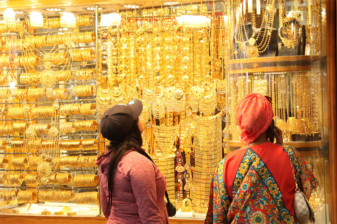
Dubai: Gold has been trading in the range of $1,200 over the past few months while the precious metal faced the precipitous correction in 2013, it has been trading in a comparatively tight range and is likely to pick up pace in the context of diverging monetary policies and a potential currency war, according to analysts at Bank of America Merrill Lynch.
Despite falling and negative rates in large parts of the world, a sustained gold rally has so far not happened, because the Fed has remained steadfast on normalising policy rates, with the dollar strength gaining momentum in recent months.
“While we acknowledge that the US economy has been cruising ahead, we believe not all is hunky dory. As such, a delayed and more muted rate hikes by the Fed would help gold break out of recent ranges. We believe the metal could rise to $1,500/oz by 2017,” said Michael Widmer, Metals Strategist.
According to BoAML analysts, gold has strong support at $1,200/oz with relatively low selling pressure as liquidations from investors have slowed compared to 2013.
“Our data suggest that gold is supported at $1,200/oz as long as investors, which remain the marginal price drivers, don’t reduce their holdings further. Of course, speculative selling has subsided to a trickle after relentless liquidation in positions a couple of years ago. Looking at this from a slightly different angle, support to gold prices on muted investor buying is heavily influenced by jewellery demand being strong enough to absorb mine and scrap supply,” said Sabine Schels, Commodity Strategist at Bank of America Merrill Lynch.
Noncommercial interest in gold has been muted because the usual market drivers have been bearish for gold in recent quarters — the dollar has strengthened, risk levels have remained low, commodities have been under pressure and real rates have by and large been trending higher on falling inflation expectations.
A potential tighter monetary policy in the US has been one of the biggest headwinds to gold. But the continuing weakness in the labour market and the relatively low inflation analysts say impending normalisation of monetary policy and its impact on the dollar has actually exacerbated the ongoing disinflation.
The Labour Department earlier this month reported that 126,000 jobs were created in March, well below economists’ expectations and the fewest added in more than a year.
Competitive devaluations
While the US has been on course for monetary policy normalisation, other institutions including the European Central Bank and the Bank of Japan are easing monetary policy aggressively. This in turn contributes to a weakening of their currencies against the dollar.
Competitive devaluations and the high FX volatility at some point are expected to work against US competitiveness.
“We see a risk that the current status quo among central banks may at some stage change. After initial rate hikes there may be a case for the Fed to slow the pace of policy normalisation against the backdrop of aggressive easing by central banks in World ex-US,” said David Woo, Bank of America Merrill Lynch FX strategist.
If the currency war intensifies, there is a likelihood of central banks globally start coordinating monetary policy. “In our view, either of these would potentially limit the upside to the dollar, which in turn may be bullish for gold,” said Schels.












